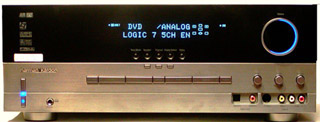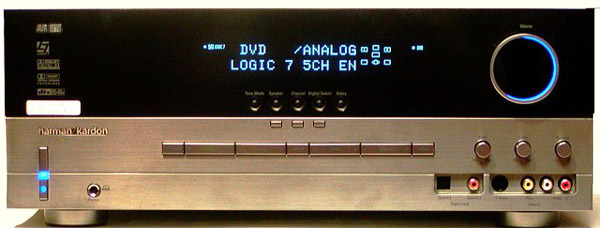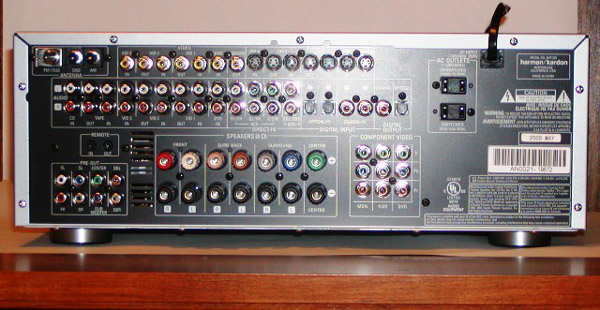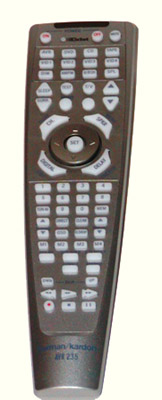Harman Kardon AVR-235 A/V Receiver
 Specifications:
Specifications:� Codecs: DD, DD-EX, Pro Logic II, IIX, DTS, DTS-ES,
DTS Neo:6, Dolby Headphone, HK Logic 7
� EZ Set Remote with Built-in SPL Meter
� Power: 50 Watts RMS x 7 into 8 Ohms;
65 Watts RMS in Two-Channel Mode THD: 0.07%
� Audio MFR: 10 Hz � 130 kHz � 3 dB
� Video MFR (Component): 10 Hz � 30 MHz -3 dB
� Dimensions: 6.8� H x 17.3� W x 15� D
� Weight: 33 Pounds
� MSRP: $549 USA
Harman/Kardon
www.harmankardon.com
Introduction
When Secrets asked me if I wanted to take part in the series on affordable
receivers by reviewing one of Harman/Kardon's new 7.1 units, I gladly
accepted.
I have been impressed with HK products in the past, and
I was eager to try out one of their newer receivers that are chock full of
features.
The Product Line
Harman International is a grouping of some very well known and successful audio brands, including Lexicon, JBL, Infinity, Harman/Kardon, Revel, and Mark Levinson.
Harman/Kardon is well known for their high-current amplifiers and
receivers. They currently have three lines of receivers to choose from. These
include digital path receivers, stereo receivers, and the AVR series of
receivers, of which the AVR 235 is a member.
The AVR series has six different receivers, and they all feature the
latest codecs, including HK's own proprietary Logic 7 sound
mode. As you move up in this product line, you get more power per channel, more
digital inputs, multi-zone support, and features to help with room set-up, such
as automatic EQ adjustment.
The AVR 235 is the lowest priced 7.1 receiver of the
bunch, at $549 MSRP. Features include seven channels at 50 watts RMS each, DD 5.1, DD PL-II, PL-IIx, DTS 5.1, DTS-ES 6.1 Matrix, DTS-ES 6.1 Discrete, and Logic 7. This receiver also features
Harman Kardon's EZ Set remote and some flexible set-up options. Let's take a
look.

Up Front
The Front Panel has a very modern look. The bottom half has a brushed metal
finish, and the top half is black. The LED display outputs in a light blue and
is complemented with the glowing neon blue of the volume knob and power
button. HK added a dimming feature for this display and it can be
dimmed to half output or no output. (Note: The power LED can't be adjusted and
remains at full luminosity.)
The LED display shows the input that is selected with the type of connection
it is using (analog or digital), the surround mode, and the
speaker configuration that is currently active. The buttons and knobs on the
front panel allow you to perform the speaker set-up, select the input, control
the AM/FM tuner, and fine tune the sound with R/L balance and tone. The front
panel also includes a digital input, an A/V input, and a headphone jack that
features Dolby Virtual Speaker technology.

On the Back
The back panel has a multitude of inputs which make this
receiver a great choice for an aspiring entertainment center with lots of
devices. Specifically, there are four composite video inputs, four S-Video
inputs, and two component video inputs. There are two digital inputs which
accept either coaxial or optical connections, and there is both six and eight
channel analog hookup for your DVD-Audio or SACD connections.
For outputs on this model, there are three composite, three S-Video, one
component video, and one digital audio output (choice of coaxial or optical) which is used
for digital recording on MiniDisc or DAT recorders for example. There is also
a full set of 7.1 pre-outs, so you can use this receiver with a stand-alone
power amplifier.
A nice addition, from an organizational perspective, is that Harman/Kardon
color coded the speaker connectors as well as the pre-outs.
 The
Remote Control
The
Remote Control
The remote is a programmable universal unit that is
able to control up to eight devices, as well as choose all the set-up options,
surround modes, and inputs of the receiver. In other words, it is crammed full
of buttons from top to bottom.
The top section of the remote lets you choose which input you want, the middle
section allows you the most commonly performed functions such as changing
volumes or channels, and the bottom buttons control the surround mode or input
specific numbers. While HK's website describes this as a backlit
remote, it wasn't obvious how to activate the backlight even after a perusal
of the manual. Given there are so many small buttons on the remote, especially
where it tapers at the bottom, it can be difficult to use at times, and even
more so in the dark.
Another issue I have with the remote is that once you press an input button,
you have to press the AVR button once again to control the receiver's volume.
You can obviate this by setting up what the manual refers to as volume
punch-through. I'd prefer a master volume button on the remote.
Despite the shortcomings with this remote, its features include macro
programming and an SPL meter, which are very convenient and useful.
Set-Up
Set-up can be performed using the LED display, but it's
easiest to use the on-screen menu (OSD or On-Screen Display), which is available by connecting a video
cable from the composite or S-Video monitor-out to your display.
One standout feature of the remote control is the EZ Set SPL meter that's
built into the top of the remote. By activating the EZ Set mode, you can hold
the remote at arm's length and let it automatically adjust each individual
speaker volume with the accompanying test tones. This feature worked pretty
well in my tests. Verifying the settings using another SPL meter, most of the
speakers were balanced while a couple of them were off by only a decibel or
less. This remote would make set-up really easy for those not accustomed to
setting speaker levels. Of course, speaker levels can be set manually as
well.
Speaker delay is set by inputting the distance to the speaker (settings are in
1 foot increments, up to 30 feet). The AV 235 also has a global delay setting which can
offset the sound of all speakers up to 80 ms. This is great for syncing up with
video sources in displays that delay the video due to processing. Secret's
Benchmark spec for this feature is 60 ms with 100 ms being preferred.
Bass management is done either by setting speaker size to Large or Small or by
adjusting the independent crossover. The independent crossover is a thankful
addition to this unit as it allows you to set the crossover of each individual
speaker to a value between 40 Hz and 200 Hz.
One feature I would have preferred to have, that is missing from this
receiver, is the ability to rename the inputs.
In Use
I placed the AVR 235 in my small entertainment room
(10'x15'). The sources included a Panasonic CP82 DVD player, an XBox,
and a PC Computer. Speakers were the Infinity TSS 750 HTIB system. I
performed my evaluation by comparing the sound of an entry level receiver
of another major brand to the sound produced from the AVR 235 in the same environment. The
other
receiver was around $250 or so, and the AVR 235 would be the next pedigree
up from that type of unit. I listened to various media using the other receiver
and then switched it out with the AVR 235 and then repeated listening to the
same media.
After even just a few minutes of sound, the types of improvements the AVR 235
made to the sound quality were obvious. Most notably, there was a lack of
distortion that was there previously and there was an exceptional clarity in
the treble range. Drum cymbals rang clean instead of having small traces of
hiss. Everything sounded clearer and the volume could be pushed much louder
without becoming harsh and painful. 50 watts x 7 (All channels driven) doesn't
sound like a lot of power, but by using efficient speakers, ample, even
excessive volume can be reached with this unit. It was certainly plenty for my
ears.
The performance of this receiver with movies and music was excellent. In
movies, dialogue was enhanced because of the clean amplifier section, and
action scenes were very exciting because of all the clarity and detail in the
treble range. In music, all the instruments sound great, with enough clarity to make even very high pitched sounds
like hi hats or cymbals sound pristine.
Listening Notes and Comments on Logic 7
I wanted to take a moment to describe the sound of Logic
7, because I found it very entertaining. Logic 7 music sounds full and more
aggressive than other sound modes. It is sensitive to the natural
characteristics of each instrument. Specifically, sounds like snare drums
would go from sounding damped or muted to sounding forward with a nice crisp
snap. Listening to the track entitled "Siegfried's Rhine Journey" on Richard
Wagner's Opera Gotterdamerung, all the French horns came alive and sounded as
they would if you were listening in a concert hall. Logic 7 adds excitement to
music listening by enveloping the listener in a landscape of sound. My only
criticism with this mode is that it made every instrument sound like it was
placed right in the center of the soundstage. I suspect this might be because
the center channel appears to be used for a lot of the voicing.
Moving along to Logic 7's Cinema Mode, the main difference I noticed, from
standard decoders, was the aggressiveness that sounds would take on. For
instance, in Disney Pixar's animation movie The Incredibles, scenes with fast
moving objects sounded very sharp and in your face. The types of frequency
ranges that are emphasized also add three dimensionality to the sound.
My conclusion on Logic 7's Music and Cinema modes is that they breathe
new life into lots of different media and are a fun alternative to the other
decoders that are available.
Video Performance with Component Video Inputs
To my naked eye, video performance with the component
video inputs on the receiver was good. This makes the AVR 235 a viable choice
for connecting two component video sources for use with one display, wired
through the AVR 235. In my tests, I set up an Xbox
directly to my 27� flat screen television using component cables. A few minutes later, I switched to inputting
the Xbox through the receiver's component video inputs and then to the
television. To my eye, the image was sharp and retained the color intensity
that component connections bring. I didn't notice any problems with blurring
or ghosting by using the receiver as a video switcher.
Conclusions
The AVR 235 is a great affordable receiver and has the
functionality and sound quality to do the job right. It's versatile enough to
connect lots of entertainment devices, and it has detailed set-up options that
will please the audiophile. The AVR 235 offers the latest surround modes, and
Harman/Kardon's proprietary Logic 7 mode is an entertaining alternative to
some of the other popular decoders. Despite a few issues with the remote
control and the lack of naming inputs, the AVR 235 is a winning product and one
that I would recommend without hesitation.
- Adrian Wittenberg -

